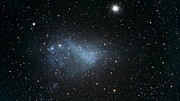Festive nebulae
Wide-field image of Magellanic clouds (ground-based image)
Globular cluster 47 Tucanae and the Small Magellanic Cloud (ground-based image)
Small Magellanic Cloud (ground-based image)
Small Magellanic Cloud and SMIDGE survey
Videos

Zoom in on NGC 248Videos
The sheer observing power of the NASA/ESA
Hubble Space Telescope is rarely better illustrated than in an image
such as this. This glowing pink nebula, named NGC 248, is located in the
Small Magellanic Cloud, just under 200 000 light-years away and yet can
still be seen in great detail.
Our home galaxy, the Milky Way, is part of a collection of galaxies known as the Local Group. Along with the Andromeda Galaxy,
the Milky Way is one of the Group’s most massive members, around which
many smaller satellite galaxies orbit. The Magellanic Clouds are famous
examples, which can easily be seen with the naked eye from the southern
hemisphere.
Within the smaller of these satellite galaxies, the Small Magellanic Cloud,
the NASA/ESA Hubble Space Telescope captured two festive-looking
emission nebulae, conjoined so they appear as one. Intense radiation
from the brilliant central stars is causing hydrogen in the nebulae to
glow pink.
Together the nebulae are called NGC 248. They were discovered in 1834 by the astronomer Sir John Herschel.
NGC 248 is about 60 light-years long and 20 light-years wide. It is
among a number of glowing hydrogen nebulae in the Small Magellanic
Cloud, which lies in the southern constellation of Tucana (The Toucan), about 200 000 light-years away.
The nebula was observed as part of a Hubble survey, the Small
Magellanic cloud Investigation of Dust and Gas Evolution (SMIDGE). In
this survey astronomers are using Hubble to probe the Small Magellanic
Cloud to understand how its dust — an important component of many
galaxies and related to star formation — is different from the dust in
the Milky Way.
Thanks to its relative proximity, the Small Magellanic Cloud is a
valuable target. It also turns out to have only between a fifth and a
tenth of the amount of heavy elements that the Milky Way has, making the
dust similar to what we expect to see in galaxies in the earlier
Universe.
This allows astronomers to use it as a cosmic laboratory to study the
history of the Universe in our cosmic backyard. These observations also
help us to understand the history of our own galaxy as most of the star
formation happened earlier in the Universe, at a time when the
percentage of heavy elements in the Milky Way was much lower than it is
now.
.
The data used in this image were taken with Hubble’s Advanced Camera for Surveys in September 2015.
More information
The Hubble Space Telescope is a project of international cooperation between ESA and NASA.
Image credit: NASA, ESA, STScI, K. Sandstrom (University of California, San Diego), and the SMIDGE team.
Links
Contacts
Karin Sandstrom
University of California
San Diego, USA
Tel: +1 858-246-0552
Email: kmsandstrom@ucsd.edu
Mathias Jäger
ESA/Hubble, Public Information Officer
Garching bei München, Germany
Tel: +49 176 62397500
Email: mjaeger@partner.eso.org
Links
Contacts
Karin Sandstrom
University of California
San Diego, USA
Tel: +1 858-246-0552
Email: kmsandstrom@ucsd.edu
Mathias Jäger
ESA/Hubble, Public Information Officer
Garching bei München, Germany
Tel: +49 176 62397500
Email: mjaeger@partner.eso.org




